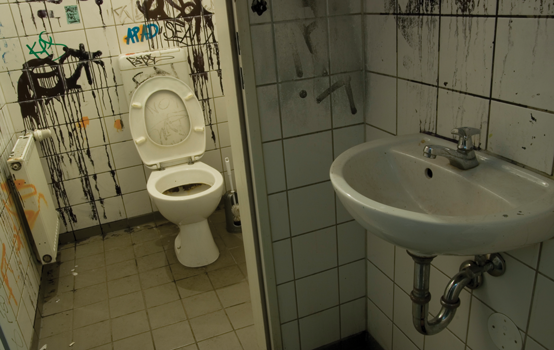As students returned to school this fall, many for the first time in over a year, they brought with them a wave of property damage. Bathrooms have been targeted for much of the destruction — across the country, children have smashed urinals, started fires, and scrawled racist messages on the walls, requiring millions of dollars in repairs.
This would be a good time for school leaders to take a good look in the mirror (provided the mirror’s still intact) and ask themselves how they can best respond to such incidents. On one hand, the public has little patience for acts of vandalism. Whenever students break soap dispensers or flood the toilets, parents and community members demand that principals and superintendents clamp down on them, perhaps by monitoring them more closely or severely punishing any misbehavior. On the other hand, no matter how harshly they respond, administrators are unlikely to put a complete stop to immature outbursts of destruction on school grounds. The real goal should be to help young people learn self-control and the responsible exercise of freedom, not to insist that they submit to authority. Rather than assuming the worst of their students, schools should provide them opportunities to grow into goodness. It may be tempting, in the short term, to lay down the law, but if we’re interested in children’s long-term development, then we must trust that they can learn to do the right thing, no matter how often they do not — that’s a necessary act of faith.
The fact is that children have been wreaking havoc in school bathrooms for well over 150 years, and educators have always struggled to respond effectively. During the 19th century, officials complained that outhouses were “defaced with obscene cuts and pencillings . . . too indecent for child or teacher to behold” (Connecticut State Board of Health, 1901, p. 28), and they worried that these smutty scrawls would supersede the school’s moral lessons, transforming students into “thieves, midnight assassins, and incendiaries” (Holbrook, 1853, p. 1). Many reformers pressed for the construction of more commodious, hygienic buildings in which “the noblest feelings of the human heart might be trained . . . instead of the ruthless disposition to destroy” (Burrowes, 1856, p. 251). They believed that, just as run-down schools corrupted children, “neatness in the furnishing induces or begets habits of neatness in the pupils” and would prevent future destruction (Freese, 1868, p. 8).
Reformers knew that taxpayers were unlikely to invest in new infrastructure only to see it defaced, so they usually coupled requests for funds to improve their facilities with stricter penalties for vandalism. School boards increasingly prohibited students “to cut, scratch, chalk, or otherwise disfigure, injure, or defile, any portion of the building” or to produce “obscene pictures or representations” on the walls, and state legislatures began to pass laws ensuring that students, rather than taxpayers, would be responsible for the cost of repairs (Barnard, 1870, p. 436).
Rather than assuming the worst of their students, schools should provide them opportunities to grow into goodness.
Unfortunately, as schools added modern amenities, children began to inflict far more damage than they could pay for. During a wave of vandalism in the 1950s, schools tried to implicate parents in their children’s destruction, but courts rejected the notion of “vicarious liability.” Unless children damaged the building directly at their parent’s behest, schools could only levy small fines rather than expecting families to cover the total costs. Whether it was $25, $100, or $500, officials complained that these fines were “simply absurd . . . in view of cases in which thousands of dollars in damage was inflicted by youngsters” (Weinstein, 1990-1991). There seemed to be no choice but for taxpayers to bear the brunt of children’s destruction.
By the 1970s, most schools had abandoned hope of shaping children’s behavior through beautification, and they turned to surveillance instead. Bathrooms were particularly vulnerable because age, gender, and status differences kept teachers from sharing the space with students, and because expectations of privacy limited the ability to supervise. The simplest response was to eradicate privacy. As early as the 19th century, toilet stalls had been equipped with shortened doors so that teachers could prevent mischief or masturbation. By the late 20th century, some schools removed stall doors entirely, installed stainless-steel fixtures, locked bathrooms during the school day, stationed monitors inside, and even installed security cameras.
Students and parents have rightly rejected these measures, which treat children with undue suspicion and violate basic claims to dignity and privacy. Their objections should remind us that the prevention or punishment of vandalism must be oriented toward promoting student growth. School buildings must permit young people some measure of freedom, even at the cost of some wrongdoing. Rather than succumbing to panic, valuing property over people, or subjecting students to unsparing scrutiny, schools must provide spaces for their autonomy. Strange as it may sound, bathroom maintenance is both a test and a testament of our faith in the future.
References
Barnard, H. (1870). Damage to school property. American Journal of Education, 19.
Burrowes, T.H. (1856). Pennsylvania School Architecture. Pennsylvania Department of Public Instruction.
Connecticut State Board of Health. (1901). Twenty-third annual report. Author.
Freese, J.R. (1868). Report on schoolhouses, and the means of promoting popular education. Government Print Office.
Holbrook, J. (1853, March 17). Democracy of science. National Era, 1.
Weinstein, T. (1990-1991). Visiting the sins of the child on the parent: The legality of criminal liability statutes. Southern California Law Review, 64, 859.
This article appears in the February 2022 issue of Kappan, Vol. 103, No. 5, pp. 67-68.
ABOUT THE AUTHOR

Campbell F. Scribner
CAMPBELL F. SCRIBNER is an assistant professor of education at the University of Maryland, College Park, and the coauthor of Spare the Rod: Punishment and the Moral Community of Schools . He is completing a book about the history of school vandalism.











